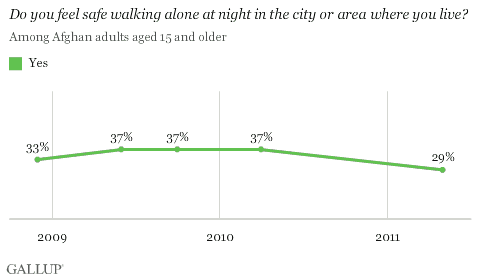TAMPA, FL -- "Suffering" in Afghanistan increased to 30% in 2011, up from 23% in 2010. The percentage of Afghans who rate the quality of their lives well enough to be considered "thriving" fell to 4% from a high of 12% in 2010. This decline erased steady gains made since 2008.

Gallup classifies respondents worldwide as "thriving," "struggling," or "suffering" according to how they rate their current and future lives on a ladder scale with steps numbered from 0 to 10 based on the Cantril Self-Anchoring Striving Scale. As Afghans have rated their lives more negatively, so have their neighbors. Suffering in Iran increased from 14% in 2008 to 26% in 2011. However, thriving in Afghanistan is five times lower than the 20% in Iran.
These findings are from Gallup's latest survey in Afghanistan, conducted in April and May 2011, after a sharp increase in violence in the country. The number of security incidents between March and June was 51% higher than the same period in 2010, according to a United Nations report. There were more suicide attacks in Afghanistan in April 2011 than any other month in 2010.
The increase in violence in the country is also reflected in Afghans' feelings of safety. Twenty-nine percent report they feel safe walking alone at night, down eight percentage points since 2010.

Employment Remains a Challenge
The unemployment rate in Afghanistan remained among the highest in the world in 2011 at more than 15%. This is unchanged from the situation in 2010, but is still higher than the 5% to 9% range measured in 2009.
Additionally, more than 35% of Afghans are underemployed in 2011. About 20% of the workforce has a formal full-time job, which ranks among the lowest percentages in the world. Gallup research has shown employment and well-being are strongly correlated, and the increase in unemployment coupled with low rates of participation in formal employment may have contributed to the increase in suffering in Afghanistan.
Bottom Line
As international forces transfer security responsibility to the Afghan National Security Forces, policymakers must be mindful of what the Afghan people think and feel. A suffering population is not conducive to a stable society. Further, pervasive violence discourages international investment and stymies efforts to create the jobs desperately needed to ensure Afghanistan's future stability. As such, efforts to bolster job growth and security clearly are both necessary and likely to feed off each other.
For complete data sets or custom research from the more than 150 countries Gallup continually surveys, please contact SocialandEconomicAnalysis@gallup.com or call 202.715.3030.
Survey Methods
Results are based on face-to-face interviews with approximately 1,000 adults, aged 15 and older, conducted in 2008, 2009, 2010, and 2011 in Afghanistan and face-to-face surveys in 2008 and telephone interviews in 2011 in Iran. For results based upon the total sample of national adults, once can say with 95% confidence that the maximum margin of sampling error ranges from a low of ±3.7 percentage points to a high of ±3.9 percentage points. The margin of error reflects the influence of data weighting. In addition to sampling error, question wording and practical difficulties in conducting surveys can introduce error or bias in the findings of public opinion polls.
For more complete methodology and specific survey dates, please review Gallup's Country Data Set details.
